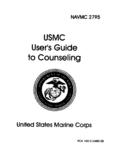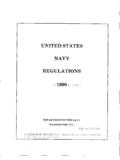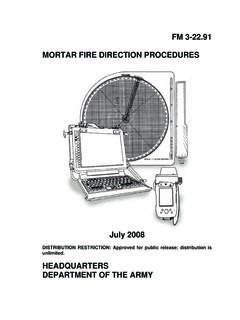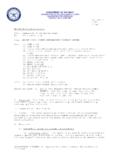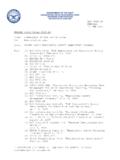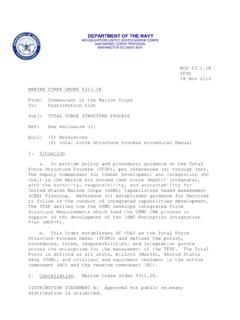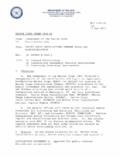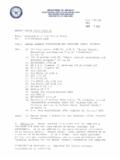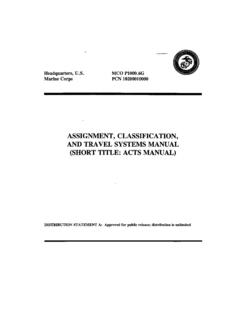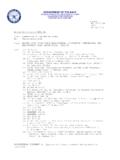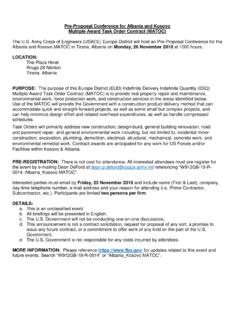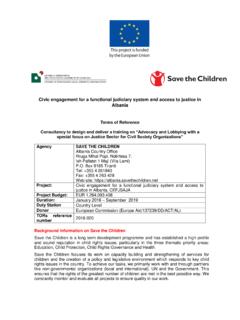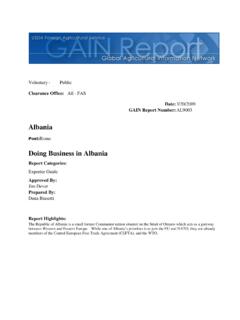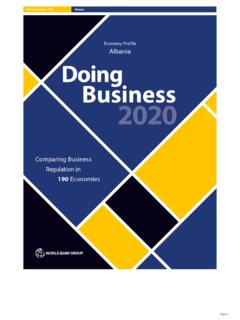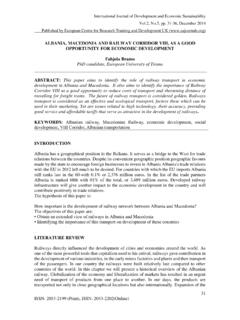Transcription of Albania: A Country Study - marines.mil
1 albania : A Country Studylivestock to markets across the Greek order, and border officialsin Yugoslavia and Greece complained of Albanians coming acrossand burglarizing Balance and Balance of PaymentsAftermore than a decade of autarky and trade surpluses, theforce of albania 's economic collapse pulled the Country 's foreign-trade balance and balance of payments into the red. albania 's ex-ports slipped more than 50 percent to about US$120 million in theearly 1990s, and the influx of emergency food and commodity aidcontributed almost half of a 20 percent increase in imports. In 1991 albania 's external current-accounts deficit, excluding official trans-fers, widened to more than US$250 million, which equaled about30 percent of the Country 's GDP before the economy seized an effort to narrow the gap, the authorities practically depletedAlbania's meager foreign-currency reserves.
2 In the late 1980s, thegovernment began ignoring the constitutional ban on foreigncredits, and by mid-1991 the Country 's total convertible-currencydebt was soaring toward US$400 million. Shortfalls in the outputof electric power, minerals, and other goods set off another sig-nificant slide in export earnings. Officials hoped remittances fromthe thousands of Albanians who had fled to Greece and Italy wouldhelp return albania 's balance of payments to an even keel, butin the early 1990s these migr s were mostly sending home hardgoods, such as used cars, unavailable in the mid-1980s, albania claimed to be carrying on trade withmore than fifty countries although the value of the goods exchangedwith most of them was small. Trade with IMF member countries,however, was in some cases substantial (see table 11, Appendix).Neighboring Yugoslavia accounted for about 18 percent of Alba-nia's trade volume; the remainder was divided almost evenly be-tween the communist and capitalist countries.
3 Tiran 's main tradingpartners in Eastern Europe were Romania, Poland, Bulgaria, andCzechoslovakia. In the late 1970s, albania 's break with Chinaforced its commercial representatives to redouble their efforts tofind new trading partners in the free-market world. The value ofAlbania's trade with the West stood at about US$200 million bythe late 1980s. In 1988 its main Western trading partners were Italy(US$65 million in trade turnover), West Germany (US$52 mil-lion), Greece (US$ million), and France (US$14 million).Albanian-Yugoslav trade, torpid throughout a decades-long chillin the two countries' relations, revived after albania 's break with162 The EconomyChina. The chamber of commerce of each nation opened officesin the other's capital city, and in 1986 a new rail line to Yugosla-via linked albania with the European rail network for the first imports from Yugoslavia included reinforcing steel, rail-road track, steel piping, cables, bricks, pharmaceuticals, electron-ics, textiles, food, and capital goods.
4 Yugoslavia imported electricpower, tobacco, chrome, bitumen, gasoline, natural gas, cognac,and food from albania . The fallout from the political crisis in Yu-goslavia' s Kosovo province, populated mainly by ethnic Albani-ans, had surprisingly little effect on Albanian-Yugoslav trade untilthe early 1990s, when war erupted between Croatia and 1991 the Albanian government and leaders of the ethnic Alba-nian community in Kosovo worked toward establishing a joint,Tiran -based commission to promote stronger economic its break with the Soviet Union in 1960, albania playedno part in the activities of Comecon. Trade with the Eastern bloc with the glaring exception of the Soviet Union, with which Alba-nia maintained no trade relations increased after albania brokewith China. Generally, albania supplied its communist-world trad-ing partners with metal ores and agricultural products; it import-ed machinery, transportation equipment, and some consumergoods.
5 The Albanians obtained rolled steel and coking coal fromPoland, pumps from Hungary, trucks and tires from Czechoslovak-ia, sheet steel from Bulgaria, and textile machinery and fertilizersfrom East Germany. The Albanians also signed a contract withHungary to build a pharmaceuticals plant in Tiran . After a five-year hiatus, China and albania resumed trade activities in 1983;the new relationship, however, lacked the intimacy of the twelve-year period of close cooperation in the 1960s and early 1970s. Al-bania carried on a modicum of trade with the Democratic Peo-ple's Republic of Korea (North Korea) and the mid-1980s, the growing interest of small import firms inthe Albanian market accounted for a sharp increase in trade withItaly and West Germany. Italy was albania 's largest Western trad-ing partner in the late 1980s. Italian exports to albania accountedfor about 20 percent of the West's exports to albania in 1985, andItaly purchased percent of albania 's exports to Western coun-tries.
6 Italy sold albania metalworking and food-processing ma-chinery, chemicals, iron and steel, metal products, vehicles, andplastics. The Italians imported petroleum products, chrome, cop-per, nickel and iron ore, and farm products from albania . In themid-1980s, West Germany accounted for about percent ofWestern exports to albania and 15 percent of Western purchasesfrom albania . Chromium ore and concentrates represented about163 albania : A Country Study50 percent of albania 's exports to West Germany in 1985. TheAlbanians bought machinery, transportation equipment, andmanufactured goods from West Germany. The collapse of Alba-nia's Stalinist economic system opened the door for greater tradewith Western Europe. In 1991 Tiran was negotiating its first eco-nomic agreement with the European Community, under which eachparty would grant the other most-favored-nation status (seeGlossary).
7 For decades albania was subject to all United States controlson exports to East European nations. The Country did not havemost-favored-nation treatment and was not eligible for credits orloan guarantees from the Export-Import Bank of the United States(Eximbank). Nevertheless, the volume of United States trade withAlbania grew from about US$1 million in 1973 to over US$20 mil-lion in 1982; it fell, however, to US$ million in 1986. In 1991the United States exported coal, wheat, butterfat, powdered milk,and other products to albania with a total value of about US$18million; to the United States, albania exported primarily spicesand fruit preserves worth about US$ million. In 1991 Albaniawas attempting to condude an economic agreement with the UnitedStates by which each nation would extend to the other most-favored-nation 's trade with developing countries, which was drivenmostly by a need to find and nurture political alliances, amountedto only about US$10 million out of a total trade turnover of US$513million reported in 1982.
8 Trade with developing countries was hin-dered because albania sold its raw materials to and bought vitalmanufactured goods from wealthier, industrialized nations. Algeria,Costa Rica, Egypt, Iran, Libya, Mexico, and Turkey had had tradeagreements with communist of TradeRawmaterials, fuels, and capital goods accounted for the bulkof albania 's foreign trade before the communist system fell apart(see table 12; table 13, Appendix). The communist regime stroveto increase the value of the Country 's exports by producing andselling industrial and semifinished products instead of raw materi-als and foodstuffs. In the late 1980s, raw materials and industrialgoods made up about 75 percent of exports, which mainly consist-ed of petroleum, chromite and chrome products, copper wire, nickel,and electric power. albania 's light industries contributed export earn-ings from sales of bicycles, textiles, handicrafts, souvenirs, woodproducts, briar pipes, and rugs.
9 Cognac, cigarettes, fruit, olives, to-matoes, canned sardines, anchovies, and other agricultural products164 The Economyalso accounted for a share of exports. In 1989 albania importedabout US$245 million in goods from the West, up from US$165million in 1988. It imported mainly capital goods, semifinishedproducts, and replacement parts necessary to keep industries, es-pecially export-producing industries, functioning. Imports includedlocomotives, trailers, machinery, textiles, synthetic fibers, lubri-cants, dyes, plastics, and certain raw materials. Consumer goodssuch as components for television sets and equipment to outfit en-terprises serving foreign tourists accounted for a smaller percen-tage of Foreign Companies in AlbaniaAlbania's1976 constitution specifically prohibited joint venturesbetween Albanian enterprises and foreign firms. However, the se-vere economic crisis of the early 1990s persuaded the governmentto create a rudimentary framework for regulating the business ac-tivities of foreign firms on Albanian soil.
10 Decrees were issued provid-ing for investment protection and the creation of joint venturesbetween Albanian and foreign companies. At least in theory, theAugust 1991 law on economic activity allowed foreign companiesto repatriate, in foreign currency, accumulated capital and profitsfrom economic activities. More than two dozen foreign companieshad already signed joint-venture contracts by August 1991. Almosthalf of the joint ventures involved small investments in shoe andtextile manufacturing, fishing, retail trade, tourism, and construc-tion. Foreign petroleum companies also signed agreements to ex-plore for petroleum reserves beneath the Adriatic Sea. Other potentialinvestors came from Italy and Greece, the Albanian migr com-munity in the West, and Kosovo's community of ethnic October 1991, albania joined the IMF and afterwardworkedto secure the IMF standby credit agreement prerequisite to receiptof credits from the World Bank and other international also became a member of the Multilateral InvestmentGuarantee Agency, a part of the World Bank Group; signed bilater-al trade accords and foreign-investment protection agreements withItaly, Germany, Greece, and Turkey; and signed an agreementwith the Overseas Private Insurance Corporation, which insuresforeign investments by United States companies.
